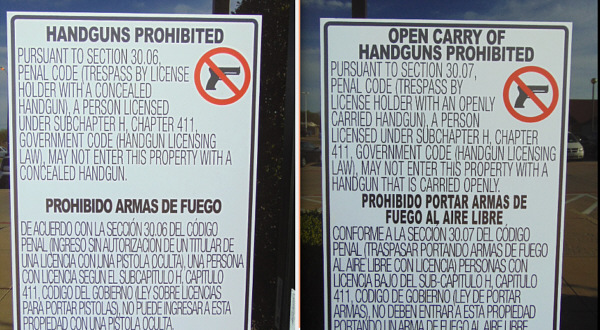

Houston: Carry Signage
and 1st Amendment Lawsuit

By Dean Weingarten. December 9, 2020
Article Source
Everytownlaw, the Bloomberg financed anti-right to arms group, is involved in a convoluted lawsuit filed in Houston, Texas.
Texas statutes prescribe signs to be posted on businesses if the presence of a person who is armed, in the business, is presumed to be trespassing. This is not unusual. The regulation of signs to give effective notice, especially in licensed businesses, is common. Posting of business licenses, for example, is often required.
The lawsuit contends this is a First Amendment issue. Their logic is, the owners might post a different sign which would serve the same purpose; but if they post a different sign to the same purpose, it would not meet the legal requirements of notice, therefore, it violates their First Amendment Rights.
Meeting a legal requirement is not a First Amendment guarantee. Here is the relevant statute. From Texas statutes at capitol.texas.gov:
(c) In this section:
1) "Entry" has the meaning assigned by Section 30.05(b).
(2) "License holder" has the meaning assigned by Section 46.035(f).
(3) "Written communication" means:
(A) a card or other document on which is written language identical to the following: "Pursuant to Section 30.06, Penal Code (trespass by license holder with a concealed handgun), a person licensed under Subchapter H, Chapter 411, Government Code (handgun licensing law), may not enter this property with a concealed handgun"; or
(B) a sign posted on the property that:
(i) includes the language described by Paragraph (A) in both English and Spanish;
(ii) appears in contrasting colors with block letters at least one inch in height; and
(iii) is displayed in a conspicuous manner clearly visible to the public.
(d) An offense under this section is a Class C misdemeanor punishable by a fine not to exceed $200, except that the offense is a Class A misdemeanor if it is shown on the trial of the offense that, after entering the property, the license holder was personally given the notice by oral communication described by Subsection (b) and subsequently failed to depart.
The First Amendment does not guarantee your speech will be legally sufficient for a particular purpose. It guarantees the government will not prevent you from making the speech. Here is the First Amendment argument, from the lawsuit:
The First Amendment safeguards the right to express differing viewpoints. "[N]o official, high or petty, can prescribe what shall be orthodox in politics, nationalism, religion, or other matters of opinion or force citizens to confess by word or act their faith therein." W. Va. State Bd. of Educ. v. Barnette, 319 U.S. 624, 642 (1943). But Texas has ignored the First Amendment and enacted legislation that singles out a group with which it disagrees—those who prefer to keep guns off of their property—and selectively burdens their speech. Specifically, Texas property owners who espouse this viewpoint must post multiple large, text-heavy signs containing language specified by the State in order to exercise the longest established and most fundamental of their property rights: the right to exclude. If these property owners use other means of indicating that firearms are not welcome on the premises—even if entirely reasonable and understandable—they cannot avail themselves of Texas's criminal trespass laws. By contrast, property owners who wish to exclude others for any other reason at all do not face these same burdens. This viewpoint-based discrimination was entirely intentional; the Texas state land commissioner who drafted these requirements admits that he "intentionally made the sign's language cumbersome" to discourage businesses from prohibiting entry to customers carrying guns.1
The owners of businesses are not prevented from posting any and all kinds of signs banning the carry of firearms which they wish. They are told how to meet the legal requirements of written notice, and what the dimensions of legal signage will be. They are given other methods as well. They can hand out written notice, or they can give verbal notice.
Trespass is seldom prosecuted in retail businesses, unless verbal notice is given in such a way as to be provable. Usually this means video proof or, more often, the management calls the police, who then observe the notice being given, or give the notice themselves.
Texas law, with the described signage, makes it easier to prosecute concealed carriers who violate the law, because it specifically says the sign is acceptable written communication.
A common problem in trespass allegations, is proving that written communication was achieved.
The First Amendment argument in the lawsuit is based on property rights.
The lawsuit claims the right to exclude others is a primary property right. They are correct. But the right to exclude others does not extend to presuming they see or understand every little written notice, no matter how small or hidden, somewhere near the entrance of a retail establishment.
To give an example: If a store places a sign, near the bottom of a front window, in 1/8th inch letters, stating "entering premises incurs a $100 surcharge", no court in the land will uphold the signage as a legal and binding contract.
A retail store is an open invitation to enter, by its nature. In order to retract or restrict entry, it must show there was actual retraction of the implied invitation.
The Texas 30.06 and 30.07 statues provide an objective way to retract the invitation.
They do not restrict the First Amendment rights of store owners. They assist the store owners by legally describing several ways of communication which the courts will accept.
By posting smaller signage, which is less clear, or in only one language, a trap could be created for those who are exercising their Second Amendment rights.
A small ideogram is insufficient, as it means many things in different places.
Common experience shows retail establishments do not actually wish to turn away customers. They may wish to have a legal "fall back" position in our litigious society.
If someone is harmed in their store, they may wish to point to an ideogram in a lower corner of a window and claim the carrier of a legal weapon had no right to be there. They ignore the potential of legal carriers to stop or deter crime.
Those opposed to an armed population have pushed the narrative that carrying arms creates more problems than it solves. There is no persuasive evidence of this.
Legal carriers are far more law abiding than the rest of the population. More legal carriers are generally associated with a decrease in crime, although the correlation is not large.
Retail stores in Texas has been given clear ways in which to communicate to customers their desire to be defenseless victim zones.
That is not a violation of the First Amendment.
©2020 by Dean Weingarten: Permission to share is granted when this notice and link are included. Gun Watch
![]()

























